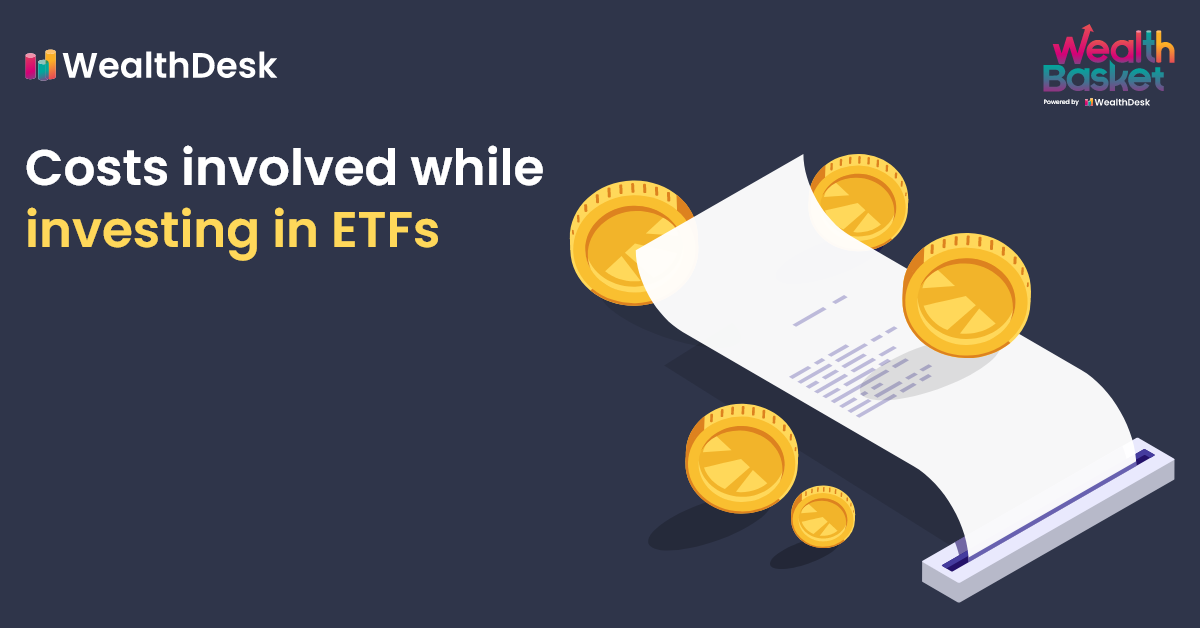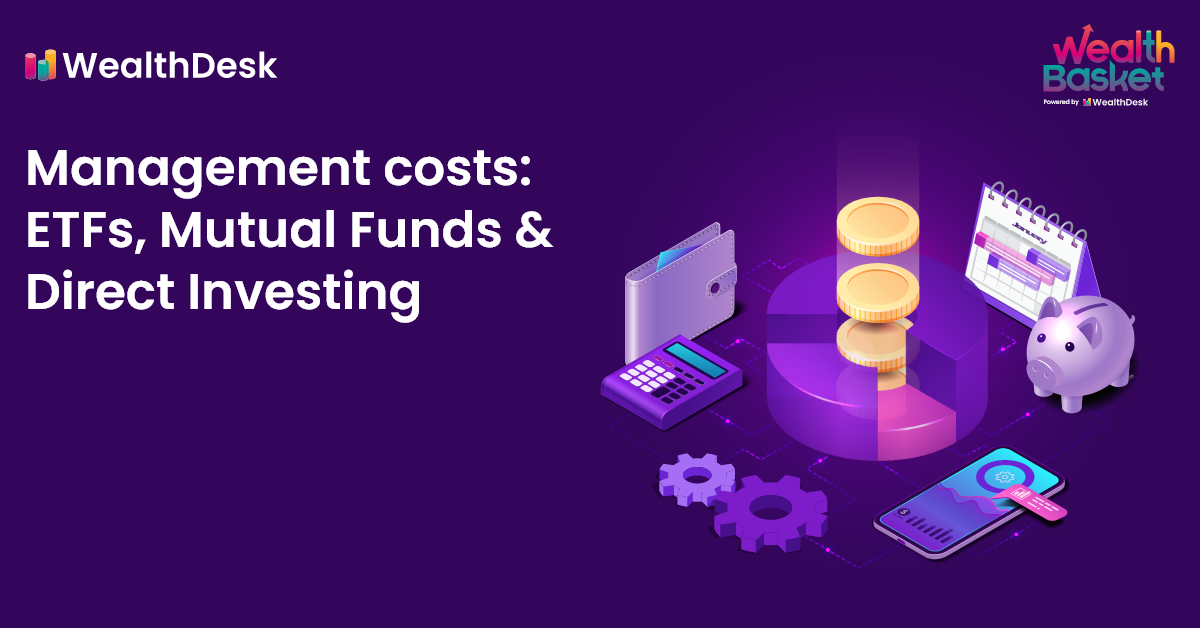What are ETFs?
Exchange-traded funds (ETFs) have the features of both stocks and mutual funds. They can be traded on exchanges just like stocks. They also spread the invested capital across assets like mutual funds.
ETFs are funds that track an asset, commodity or index (Nifty, SENSEX, etc.). You may also find ETFs that follow a particular investment philosophy. E.g., in 2016, momentum investing ETFs were launched by Fidelity in the US.
Index ETFs that track particular indexes are the most widely known ETF category. This has led to index ETFs being thought of as a synonym to ETFs. However, while index ETFs are passively managed and cost lower than mutual funds, all ETFs may not have the same features.
Thus, it is essential to verify the costs associated with ETFs.
Example: Smart Beta ETFs are available in India. These ETFs follow a particular investment strategy within a particular index.
What are the Costs Involved with Investing in ETFs?
For any fund, we can divide the costs into 2 types:
Management Costs
All funds charge a fee for providing their services. Typically, a fund will use a part of the invested money for funding the salaries of the fund manager, their staff, expenses of the assets and tools, research expenses, field visits and management and administration expenses. All these costs are represented by the expense ratio. We read about expense ratios and the various costs involved in managing a fund later on in this article.
ETFs are widely regarded as having low costs because of the confusion between index ETFs and ETFs in general. As we have warned earlier, this can be a very inaccurate understanding of the costs involved.
Inspecting the expense ratio before buying would save an investor from any ugly surprises. It is important to note that management costs depend on whether the fund is actively managed or passively managed and may not depend a lot on the structure of the fund.
ETF Transaction Costs
Trading in ETFs would involve costs like brokerage fees, taxes, BSE or NSE charges, GST, SEBI charges and stamp charges. These costs are comparable to the ones involved in trading other securities like stocks.
We have listed the transaction costs of ETFs below:
| Charges | Amount |
| Average Brokerage | 0.01% of the turnover value |
| Security Transaction Tax (STT) | 0.1% on buy & sell |
| Transaction charges | ⇒ NSE= 0.00345%⇒ BSE= 0.00345% |
| GST | 18% on (brokerage + transaction charges) |
| SEBI Charges | ₹10 / crore |
| Stamp charges | 0.015% or ₹1500 / crore on buy-side |
Discover stocks that suit certain filter criteria and dive into details to check their WealthBaskets.
Comparison of ETF Transaction Costs With Mutual Funds
What are entry and exit loads?
A load is a sales charge or commission charged to an investor when buying or redeeming units. For example, if a fund has a 2% entry load and you invest ₹10,000, you will be charged ₹200 as entry load. You would effectively be investing ₹9,800. To break even, you would have to earn ₹200 back.
Similarly, exit loads are charged when an investor takes their money out of the mutual fund. If the amount disinvested is ₹9,800 and the exit load is 2%, then the exit load would be ₹196. We would get ₹9,604 back out of the ₹9,800 we pulled out.
Unlike mutual funds, ETFs don’t carry entry or exit loads. However, brokerage charges are applicable as ETFs are traded on the exchange. As low-cost discount brokers became prominent, it led to a reduction in ETFs’ entry and exit fees. This is one of the reasons ETFs are talked about as low-cost alternatives to mutual funds.
What is expense ratio? How does it vary between ETFs and mutual funds?
Expense ratio refers to the fraction of a fund’s assets used towards administrative and other operating expenses. These expenses include the portfolio manager’s salary, the salary of their staff, research, technical equipment, computers, and travel expenses to send analysts to meet corporate management.
Actively managed funds generally have an expense ratio between 0.5% and 1.0%, rarely exceeding 2.5%. Passive index funds have an expense ratio of about 0.2%.
The momentum ETFs discussed earlier is an example of actively managed ETFs. Active management is preferable only when the fund manager can outperform the index returns. It would not make sense to pay for the fund management services in any other case.
It is a misconception that ETF expense ratios will always be lower than mutual fund expense ratios. Indian markets have both, active and passive variants, of mutual funds and ETFs. So it is important to know if the fund is actively managed or passively managed. To learn about the effect of the expense ratio on returns, you must learn how it is calculated.
How is expense ratio calculated?
What is total expense ratio?
Expense ratios are sometimes referred to as Total Expense Ratios (TER).
What are 12B-1 Fees? How do they vary between ETFs and mutual funds?
12B-1 is a marketing fee charged by mutual funds. It is typically computed as a part of the fund’s expense ratio. Masking the fees inside the expense ratio is considered as disguised commission. 12b-1 may run up as high as 0.25% in an entry-load fund and 1% in an exit-load fund.
It’s not always clear how much the 12b-1 fees would be. These fees are intended to pay for promotion and advertising, however, only 2% of the fees are used for that. The rest is paid to the brokers who sold the mutual funds. On an annual basis, 98% is paid to the broker for as long as you hold the mutual fund.
Are ETFs cheaper than stocks?
What is the expense ratio in stocks?
Since investing in stocks is a direct investment, management costs are absent. Instead, it is the responsibility of the investor to monitor the performance of the portfolio. The responsibilities of rebalancing the portfolio, i. e. entering and exiting from stocks, would also fall on the investor. Another aspect of managing a stock portfolio that should be considered is having to conduct and verify research on your own on top of the daily workload in one’s own personal/business life.
Thus, we see that while stocks do help save on the management costs, they also leave the investor with the responsibility to make the transactions, monitor the performance, conduct, verify and analyse research.
If an investor feels confident in their ability to conduct these activities and has the time for it, they may go ahead with direct stock investments. However, it may not be feasible for people with full-time jobs or businesses to look after.
ETFs on the other hand incur similar transaction costs and have management costs only if you pick the actively managed funds. For investors looking to be free of the duties involved with direct investment, ETFs may be a better alternative.
The Takeaway
Over the course of the blog, we have discovered the various costs associated with investing in ETFs and how they compare to mutual funds and stocks. They are a great way for investors to diversify and offer a lot of flexibility. They are built to be less volatile than stocks and have more liquidity than mutual funds.
The costs involved would depend on the nature of the fund. Actively managed funds have higher costs than passively managed funds. The structure of the funds may not give them an edge in regard to cost.
On WealthDesk, you can find portfolios of stocks and ETFs called WealthBaskets curated and managed by SEBI registered WealthBasket managers. The underlying assets (stocks and ETFs) are on the investor’s Demat account. With WealthBaskets, investors can invest without a lock-in and apply one-click rebalancing updates.
You can check out the various WealthBaskets
FAQs
ETF management fees are typically marked as the expense ratio. They are calculated as a percentage of net asset value, averaged out over a year. They are not paid directly and an investor may not need to transfer funds for paying these funds. They are deducted from the net asset value of the fund itself.
Some ETFs do pay dividends. These dividends may be paid on a regular interval specified by the ETF. ETFs which do not pay dividends, reinvest the dividends received by them on the underlying securities.
While this may be true on average, it is a
misconception to think that all ETFs would be
cheaper than mutual funds just because of their
structure. Most ETFs have passively managed index
funds which help them save on the management costs
and thus makes them appear cheaper.
However, the costs of funds depend on
the type of management. Passively managed funds are
cheaper than actively managed funds.


















